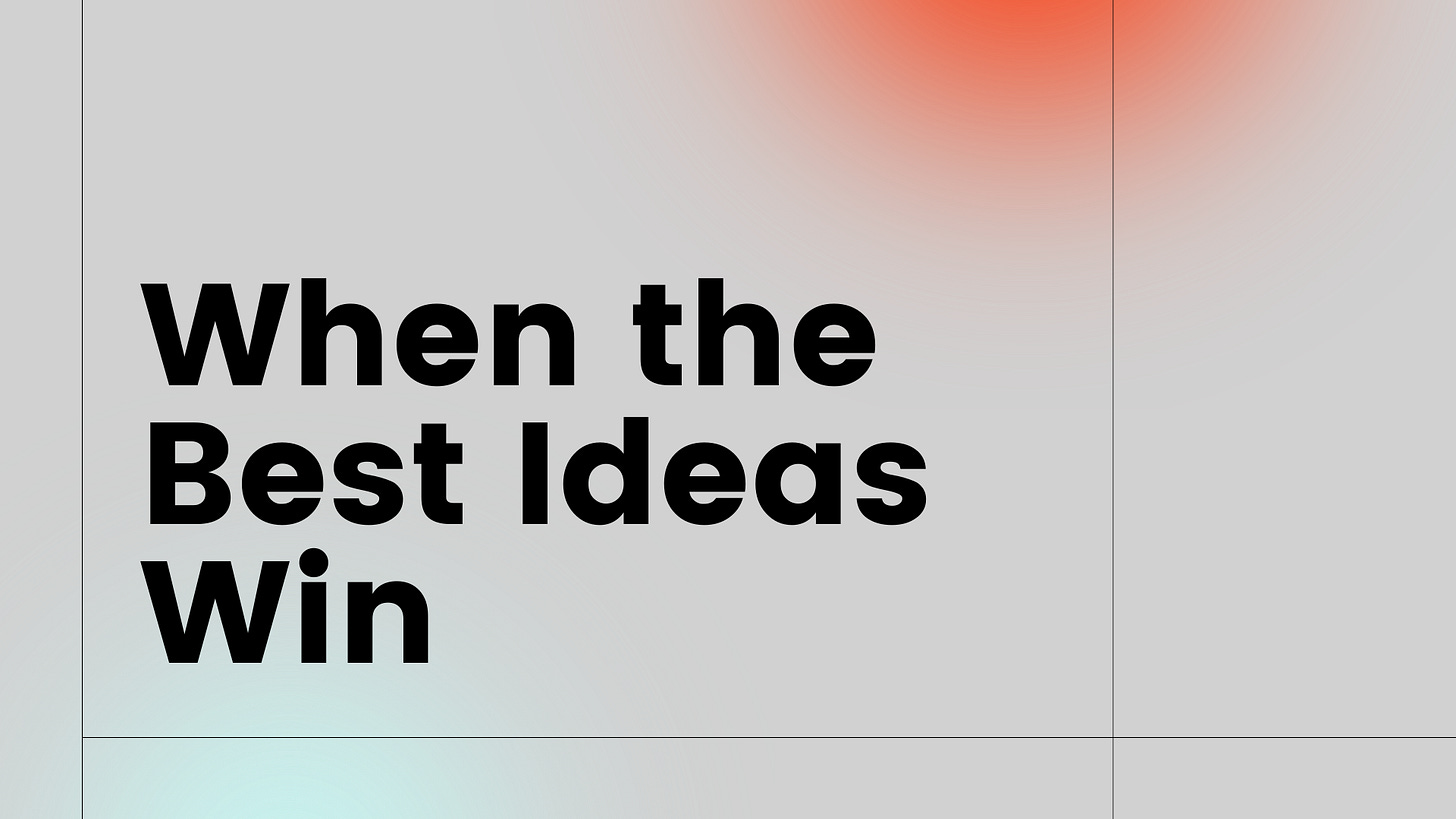Hey there 👋
My name is Conor. I’m helping shape how teams work together at Hugo, bringing your meetings, notes, and tasks all in one place.
If you’re enjoying the newsletter, click the button below to share it with a friend. Help get Future of Teamwork to 1K subscribers!

At Hugo, we consider meetings to be a common operating system for teamwork. If we can innovate around how we collaborate, we can gain a competitive advantage.
One advantage we have developed comes from the way that we share information and make decisions in meetings. It’s a process that helps ensure that meetings always surface our best ideas.
💥 Introducing Idea Meritocracy
Every challenge in business has the potential for plenty of complexity. The ingenuity and creativity to solve these problems can come from anywhere, but only if you encourage ideas from all elements of the workforce. That means being transparent about challenges, and actively listening to people — even if they are discussing topics outside of their area of specialty.
This practice called an idea meritocracy is a secret weapon that helps you make better decisions and rapidly solve hard problems.
Simply put, an idea meritocracy is an environment in which the best idea wins. We didn’t come up with this idea on our own; companies such as Pixar, Intuit, and Google have adopted idea meritocracies with great success.
In their book How Google Works, Eric Schmidt, former CEO of Google, and Jonathan Rosenberg, former Google senior vice president of products, discussed why they embrace the power of an idea meritocracy:
“In most companies, experience is the winning argument. We call these places ‘tenurocracies,’ because power derives from tenure, not merit . . . Meritocracies yield better decisions and create an environment where all employees feel valued and empowered.”
In his book Principles, Ray Dalio outlines how to turn your organization into an idea meritocracy. Dalio suggests you operate with radical straightforwardness, a combination of truthfulness and transparency where you deal with issues openly.
If the concept of an idea meritocracy makes you feel both excited and uncomfortable, you’re not alone. Yes, it can be challenging on an emotional level, as it requires vulnerability and humility from everyone involved. But ask yourself what kind of work environment you want to craft for yourself and your team. Then try answering the following questions:
Do you want your team to make the best decisions?
Do you want your team to constantly improve and innovate?
Do you want your employees to be more highly engaged and become the best thinkers and learners that they can be?
Do you want your organization to be more proactive, agile, and adaptive?
🛠 Idea Meritocracy in Action
It sounds almost utopian! But here’s the tough part: In an idea meritocracy, how do you decide which idea is best?
First, let’s look at how you don’t decide. In an idea meritocracy, factors such as positional power, pay, and even experience become nearly irrelevant compared to objective measures, such as the quantity and quality of data and how it is interpreted.
To help determine which idea is best, Ray Dalio suggests you start by addressing your own opinion as one of many. Then ask yourself how you know whether or not your opinion is right. This will help shift your perspective by focusing your attention on the right criteria to make this decision. Dalio says:
“This eliminates one of the greatest tragedies of mankind . . . people arrogantly, naïvely holding opinions in their minds that are wrong, and acting on them, and not putting them out there to stress test them.”
Consider these practices and ideas as you implement idea meritocracy into your team process and culture:
Team member contributions should not be defined by what they know or how much they know — but rather by the quality of their thinking, listening, learning, and collaborating.
Mental models are not the same as reality — at best, they are generalized ideas about how the world works.
Ideas do not equal ego. To have the right idea or a wrong idea is not to be right or to be wrong.
Treat all beliefs as hypotheses to be constantly tested and subject to change based on better data.
Mistakes and failures are opportunities to learn.
Ideas often come from people on our team who aren’t directly responsible for the solution. This new way of working presents an opportunity for fast-moving teams to outperform others by leveraging the ideas of their whole team — including remote workers and decentralized teams.
📚 Reads of the Week
Independence, Autonomy, and Too Many Small Teams
I’ve always liked the “two-pizza” paradigm in the context of organizing teams, but this essay from Kislay Verma made me reconsider my views here. Scaling autonomous teams with aligned incentives isn’t an easy problem to solve.
The State of Business Play
I’ve been hooked on Venkatesh’s writing lately and this post is a good example of why. If you’re strategically in the know at your company, try your hand at this list of questions.
Most Products Fail
I read about this project from Kenny Ning when it first came out and was super impressed. Fast forward some time, and stakeholder adoption wasn’t where they wanted it to be. Stories like this don’t get shared enough.
Thanks for reading Future of Teamwork this week! Did anything stand out? I’d love to hear about it. Reply to this email or tweet at me and let’s chat 😁
Until next time,
Conor


